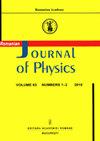通过模拟将新型异质结构的 CIGS 太阳能电池效率提升至 34.5
IF 1.2
4区 物理与天体物理
Q3 PHYSICS, MULTIDISCIPLINARY
引用次数: 0
摘要
"这项研究利用 SCAPS 探索了基于 CIGS 太阳能电池的高效异质结构的光伏性能。研究探讨了不同厚度和掺杂密度下的各种电气规格。首先,研究了 ITO/GaSe/CIGS 异质结构的光伏特性。结果显示,优化后的 PCE 为 22.59%。然后,在该结构中采用了强掺杂 p 型薄膜(CIGS-p+)。CIGS-p+ 层的加入将 PCE 提高到 31.94%。拟议的 CIGS-p+ 层被解释为用作背表面场。通过在吸收器和钼背触点之间添加第三层 p-MoS2 二卤化过渡金属材料界面层,该结构得到了进一步改进。添加第三层界面层意味着效率提高了 34.55%。结果表明,CIGS/Mo 接口上的 MoS2 层使其从肖特基型接触变为准欧姆接触。结果证实了界面层对 CIGS 异质结构的有利影响。此外,光伏电池的性能与吸收层的缺陷强度有关,在低于 1 1018 cm-3 的水平时会出现衰减。基于 ITO/GaSe/CIGS/CIGS-p+ 的结构在三种受检系统中表现出最高的性能稳定性,不受温度变化的影响"。本文章由计算机程序翻译,如有差异,请以英文原文为准。
Boosting Efficiency Up to 34.5 % of CIGS-Based Solar Cells Using a New Heterostructure by Simulation
"This work explores the photovoltaic performance of a high efficiency heterostructure based on CIGS solar cells using SCAPS. Various electrical specifications were explored at various thicknesses and doping densities. Initially, photovoltaic characteristics of the ITO/GaSe/CIGS heterostructure are investigated. The results show an optimized PCE of 22.59%. Then, a thin film strongly doped p-type is employed (CIGS-p+) to the structure. The engagement of the CIGS-p+ layer increases the PCE to 31.94%. The proposed CIGS-p+ layer is interpreted to serve as a back surface field. The structure is further improved by adding a third interfacial layer of p-MoS2 transition metal dichalcogenide material between the absorber and the Mo back contact. Adding a third interfacial layer implied an efficiency increase of 34.55%. The results reveal that the MoS2 layer at the CIGS/Mo interface adapts it creating Schottky-type contact to quasi-ohmic contact. The results confirm the beneficial influence of the interface layers on the CIGS heterostructure. Additionally, the performance of the photovoltaic cell against the defect intensity of the absorber layers is found to degrade behind a level of 1 1018 cm–3. An ITO/GaSe/CIGS/CIGS-p+ based structure exhibited the highest stability in performance against the temperature change among the three examined systems."
求助全文
通过发布文献求助,成功后即可免费获取论文全文。
去求助
来源期刊

Romanian Journal of Physics
物理-物理:综合
CiteScore
2.30
自引率
26.70%
发文量
0
审稿时长
4-8 weeks
期刊介绍:
Romanian Journal of Physics was first published in 1992 as a continuation of the former Revue Roumaine de Physique (ISSN: 0035-4090), a journal publishing physics and engineering scientific papers established 1956 with deep roots in the early history of the modern Romanian physics.
Romanian Journal of Physics is a journal of the Romanian Academy published by Editura Academiei Romane (eA). The journal has an international character intended for the publication of original physics contributions from various sub-fields including the following:
-Theoretical Physics & Applied Mathematics
-Nuclear Physics
-Solid State Physics & Materials Science
-Statistical Physics & Quantum Mechanics
-Optics
-Spectroscopy
-Plasma & Laser Physics
-(High Energy) Elementary Particles Physics
-Atomic and Molecular Physics
-Astrophysics
-Atmosphere (Environmental) & Earth Science
-Environmental Protection
 求助内容:
求助内容: 应助结果提醒方式:
应助结果提醒方式:


